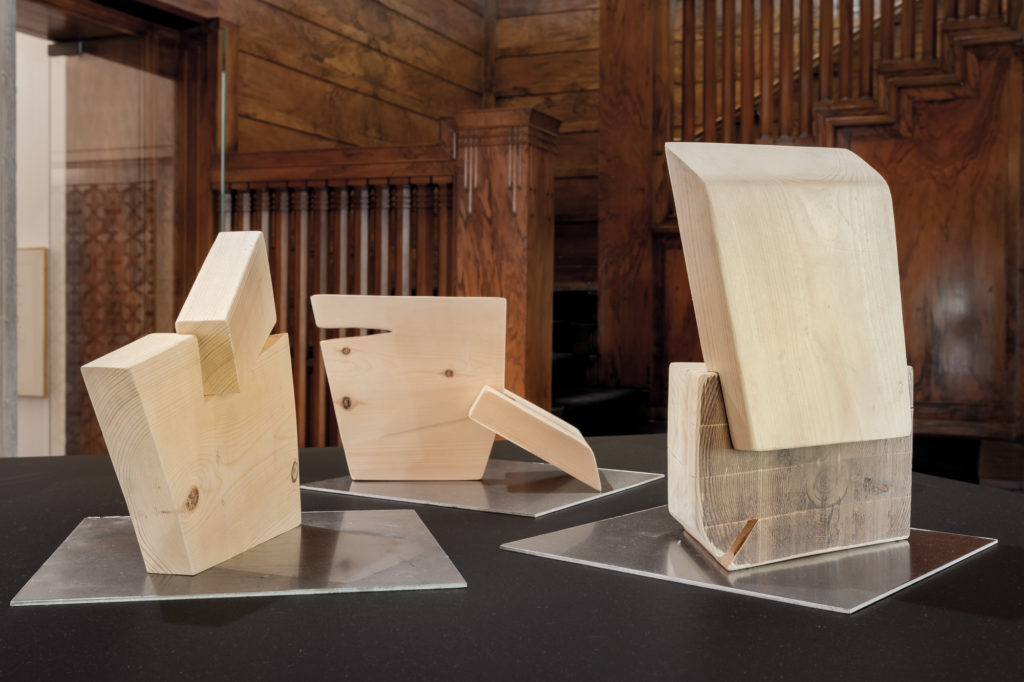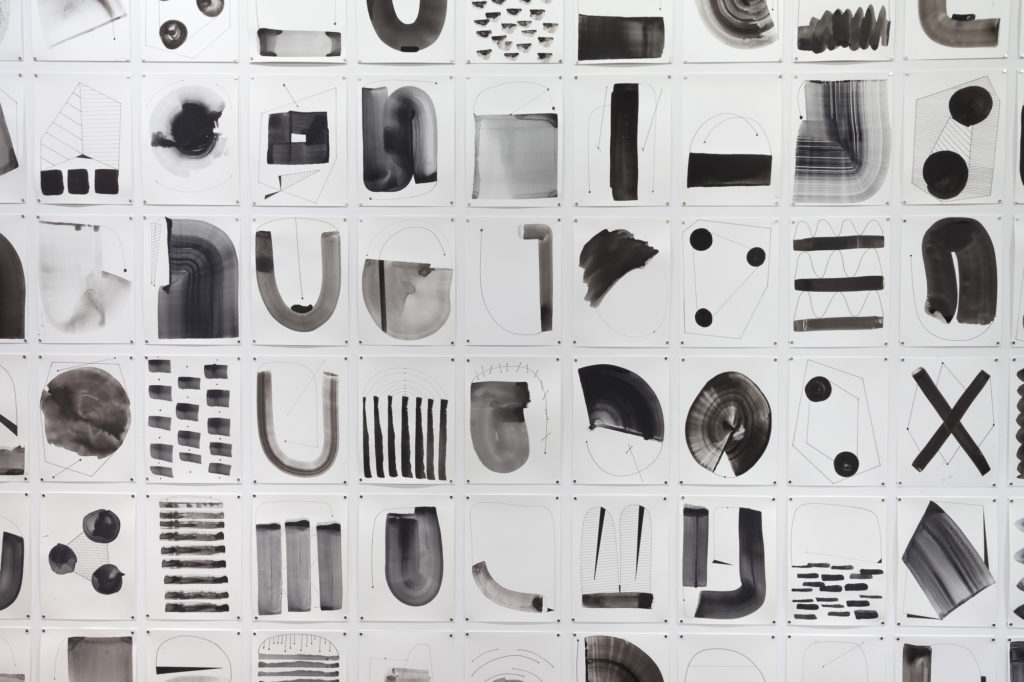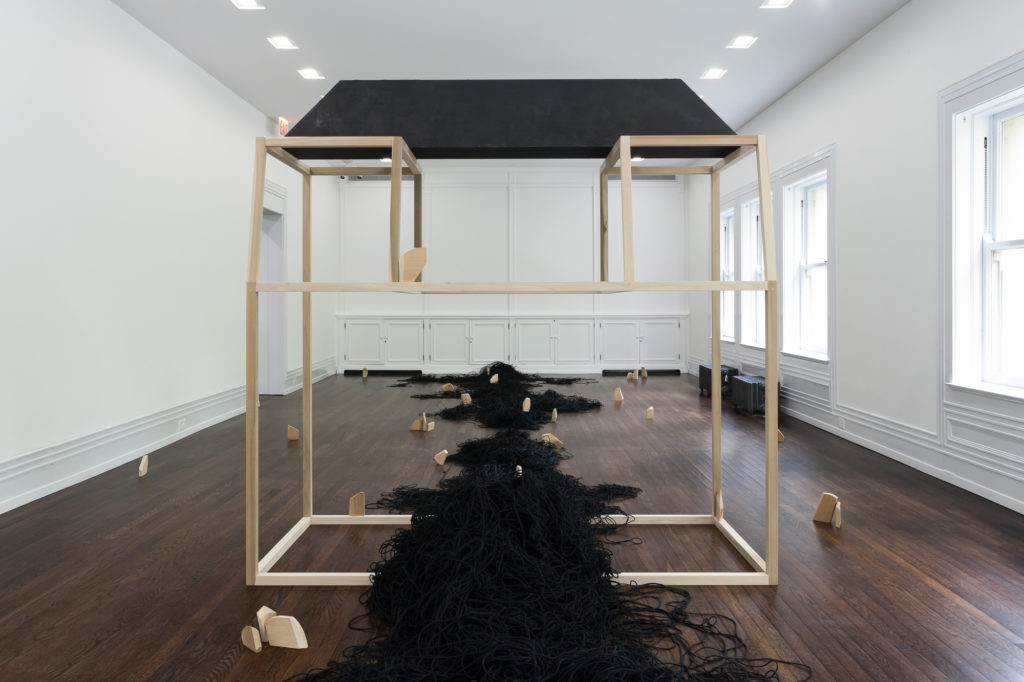Torkwase Dyson: Wynter-Wells School // The Graham Foundation
by Mary L. Coyne
On a day I compared to Miami in Chicago where drawing a breath was a struggle, a struggle made real by his sharp attire a rag + bone ruggedness
solitary
changes into a black cut-off T and cigarette pants
A black body among black sculpture yet both are doing something other than that
There an attempt a free-throw in loafers a non-sportsman
An attempt and not an actuality
a caged animal spirit an awkward moment of applause “that’s it!”
The previous text is a response to a movement performance by Zachary Fabri, an interdisciplinary artist and one of a network of scholars, artists, writers, thinkers, designers, and advocates with whom Torkwase Dyson workshopped as part of the Wynter-Wells Drawing School for Environmental Liberation. Within the context of Dyson’s fluid and dialogic system guised as an exhibition, which occupied the Graham Foundation for the Advanced Studies in Fine Arts from May to July 2018, Fabri’s performance so ideally embodied the layers of analytic and critical distance at the core of Dyson’s expanded drawings, and their effects of color, form, and relation.
Dyson’s practice applies tools of abstraction within a field of spatial justice alongside a radical ontology consistent with a contemporary return to the object—a subjective approach to being and objecthood that develops the definitions of both to include, among other concepts, minds, lived bodies, language, signs, power, and social structures.1 Departing from this social ontology, Dyson explores the possibilities offered by abstraction “as a tool that you try to put in a place when you are trying to articulate something.”2
Dyson attributes this interest to the way in which architecture, urban planning, and design contribute to the lived realities of human and non-human life, as well as to her youth in the Southern regions of the United States. For Dyson, abstraction operates as a tool to reveal and examine the potentialities within the design of our physical world towards a self-emancipation, or what the artist often refers to as “hostile geographies.”3

#5); Untitled (Hypershape, Wood Work #7), 2017. Pine on aluminum, 14 x 7 x 10 inches; plate 12 x 12 inches. Courtesy of Rhona Hoffman Gallery. Graham Foundation, 2018. Photo Credit: RCH.
In 2016, Dyson designed and built Studio South Zero (SSZ), a solar-powered mobile studio where the context of nomadism became the framework for learning and making art about the environment. It was traveling with SSZ that inspired her experimental project, The Wynter-Wells Drawing School for Environmental Justice. Dyson defines this as a “conceptual project in environmental pedagogy,” exploring the contemporary theorizations of space, architecture, and the infrastructure of Sylvia Wynter—a Jamaican cultural theorist whose work on race, location, and time inform a definition of humanity—and Ida B. Wells—a newspaper journalist and editor dedicated to exposing systemic racism in the American South. Occupying Chicago’s Graham Foundation for a residency, the Wynter-Wells School extended the connection to Dyson’s native Chicago’s own lineage of a generation of forcibly displaced Bauhaus thinkers. However, in place of delineating a historic view of political architecture, Dyson instead suggests that space itself—its formation, and movement within an architectural mode of perception—is a gesture of historical radicality.
By re-thinking these spatial realties, Dyson offers the opportunity for alternatives that challenge the order of things.4 Considering Dyson’s work within Christina Sharpe’s 2016 book, “In The Wake: Blackness and Being,” the realities of existing as a black body against a history of oppression, the residual effects of which cannot, according to Sharp, be negated. For Sharpe, there is not much beauty in the Wake—it is downed, seemingly by necessity, by terror. While acknowledging the reality of the wake, Dyson insists on beauty: begrudging the fetish of personal trauma, denying the tragedy of the individual for an affect, and instead speaking the language of tone, element, and spatial relation. As an energetic teacher and generous spirit, Dyson’s persona adjusts the lens of this tragedy, offering a counterpoint to Sharpe’s analysis of post-colonial life. In its place, Dyson’s work brings a beauty to what Sharpe terms the “afterlives of slavery.” A beauty that holds, reminds us of, and centralizes the “history of people being in the hold.”5

It is important here to emphasize Dyson’s architectural thinking, which shares as much of an affinity for the structure-cum-objects of David Adjaye’s projects, such as Elektra House (1998–2000) in London, whose textured facade quietly and resolutely interrupted the ninetieth century row houses known for offering a more traditional attitude towards domestic life. In his practice, Adjaye refers to a history of Minimalism, to which Dyson’s work unapologetically also adopts, setting off a claim around interaction, object, and connectivity.6 Where Donald Judd’s objects are described as “discrete,” Dyson’s practice builds out of a spatial awareness of interior and exterior toward betweenness. In her 2015 sculptural work, entitled Edged Into a Void (Garret #2) Dyson’s trapezoidal form exists as both an abscess and a rise, a geometrical wave, a sense of movement. This sense of motion that compels contemplation and expansion of what histories, and critiques, form can serve. Like Adjaye, Dyson, relies on starting her work from a shared experience that is neither completely articulated nor universal. Her work does not eschew the cannon of minimalism or seek to correct its limitations, but instead finds a power within it.
In a drawing workshop lead with Ron Henderson, Director of Landscape Engineering and Urbanism at Illinois Institute of Technology, Dyson unpacked the works on paper included in the Graham exhibition, such as Tuning (Hyper Shape, 200– 410) (2018), a grid of two hundred and ten small-scale section drawings. Adopting formal architectural drawings styles, Dyson does not so much reveal data otherwise unknown, but instead opens its negative space. It is in the negative space, that revealed by section drawings, where Dyson finds the greatest potential of draftsmanship, and as her work best allows, a practice of expanded drawing. Dyson articulates the act of drawing “as a pedagogical tool towards critical practice,” and adds that “abstract drawing can lend itself to the intellectual and psychological pursuit of pulling black compositional thought close.”7 In Black (Hyper Shape) (2017) Dyson meditates on this interval, an interval that extends into the present moment of recognition. The gap in Black (Hyper Shape)—a space of a few inches between wooden panels—is an object that signifies, but more importantly enters a relation with countless other objects.

While favoring abstraction through objects, Dyson emphasizes a literary platform from which the work departs—her recent residency at the Graham Foundation was punctuated with not only a series of drawing workshops, but also with a reading list of texts ranging from bell hooks to Rosalind Krauss to multiple object-oriented otologists and, of course the two women for whom the project was named. This all serves as the preamble to Dyson’s solo show at Rhona Hoffman Gallery, Torkwase Dyson: James Samuel Madison, which acts as a celebratory moment of homecoming for Dyson. Perhaps nowhere else than Chicago offers a better context for the intermingling of social architecture, human history, and critical design that speaks so directly to Dyson’s continued work.
Torkwase Dyson (b. Chicago) received her BFA from Virginia Commonwealth University and her MFA from Yale School of Art. Based in New York, Dyson describes herself as a painter who uses distilled geometric abstraction to create an idiosyncratic language that is both diagrammatic and expressive. The works are deconstructions of natural and built environments that consider how individuals negotiate and negate various types of systems and spatial order. She began engaging social architecture through her project Studio South Zero (2014–ongoing), a mobile studio that relies on solar power and supports multidisciplinary artmaking. Recent solo exhibitions of Dyson’s work have been presented at the Graham Foundation, Chicago; Drawing Center, New York City; Landmark Gallery, Texas Tech University, Lubbock; Eyebeam, Brooklyn; and the Meat Market Gallery, Washington, DC. Her work has also been included in exhibitions in New York at the Whitney Museum of American Art; the Studio Museum in Harlem; Martos Gallery; Postmasters Gallery; and We Buy Gold, Brooklyn as well as at the Schuylkill Center for Environmental Education, Philadelphia, and the National Museum of African Art, Washington DC. Dyson’s work has been supported by the Joan Mitchell Foundation; Nancy Graves Foundation; Nicholas School of the Environment, Duke University; and the Lower Manhattan Cultural Center. She is on the board of the Architectural League of New York and is a visiting critic at the Yale University School of Art. She is represented by Davidson Contemporary, New York and Rhona Hoffman Gallery, Chicago.
- Levi R. Bryant The Democracy of Objects (Ann Arbor, University of Michigan: Open Humanities Press, 2011), 35.
- Torkwase Dyson artist conversation with Andres Hernandez and Zachary Fabri, June 29, 2018, Graham Foundation
- Torkwase Dyson “Black Interiority: Notes on Architecture, Infrastructure, Environmental Justice, and Abstract Drawing” Pelican Bomb January 9, 2017. Accessed July 17, 2018.
- See Demetrius L. Eudell “Come on Kid, Let’s Go Get the Thing: The Sociogenic Principle and the Being of Being Black/Human,” in Sylvia Winter: On Being Human as Praxis p. 231.
- Christina Sharpe In the Wake: On Blackness and Being (Durham, North Carolina: Duke University Press, 2016); Torkwase Dyson quoted during public conversation at the Graham Foundation June 29, 2018.
- Okwui Enwezor “Gestures of Affiliation,” in David Adjaye: Form, Heft, Material (New Haven: Yale University Press, 2015). Published on the occasion of the exhibition at the Art Institute Chicago and Has der Kunst, Munich.
- Torkwase Dyson “Black Interiority: Notes on Architecture, Infrastructure, Environmental Justice, and Abstract Drawing” Pelican Bomb January 9, 2017. Accessed July 17, 2018.